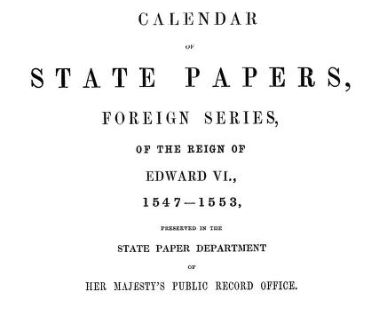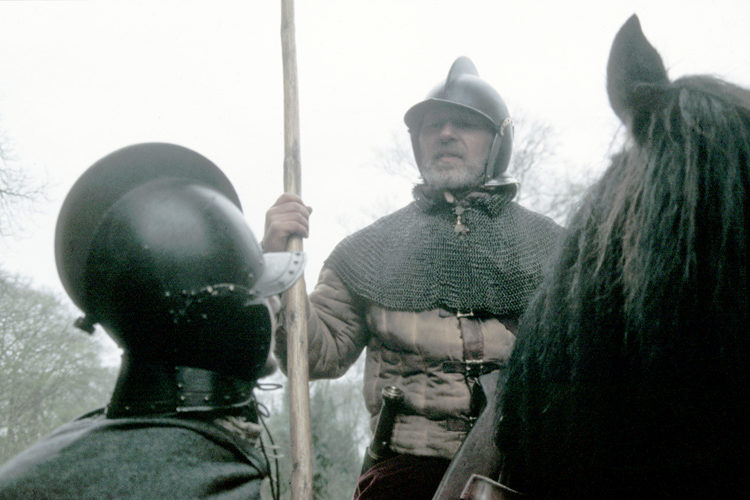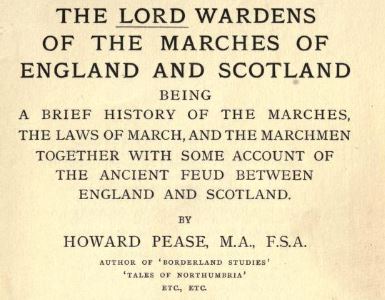“The Scottish navy was powerful enough and enterprising enough to interfere with the commerce of…
England Scotland wars and raids
[This is raw database entry from file L records not used. This entry to be clarified and illustrated later.]
L1002
Henry VII Order to Carlisle to Defend Against Scots
Letter from Henry VII ordering Carlisle to improve its defences against Scottish attacks.
In 1498 the Scots continued to be a threat to the English kingdom and Carlisle, being so close to the border, remained one of the chief pillars of its defence.
Not only were successive governments prepared to spend money on fortifications and arms, but the citizens of Carlisle were exhorted, as in this letter, not to join any private army or any raiding expeditions but instead to stay at home and defend their city! The letter starts … ‘Inasmuch as you know well that the same our city is one of the chief keys and fortresses to the defence of this our realm and that the loss thereof by any sudden enterprise of the Scots should be not only your all destruction but also a great woundful hurt to all our said realm which God defend …‘
Letter to the mayor and citizens of Carlisle from Henry VIII.
Insomuch as you know well that the same our city is one of the chief keys and fortresses to the defence of this our realm and that the loss thereof by any sudden enterprise of the Scots should be not only your all destruction but also a great and a woundful hurt to all our said realm which God defend. We therefore will and charge you most straightest wise not to suffer any loss of person or persons dwelling within our said city. Do not ride or pass out of the city to indulge in skirmishings, affrays riots with any estate or degree he be, but to be city in harness to gentleman or other abiding and attend same our city for any fields or whatsoever of ing at all seasons both of war and of p the defence and surety thereof against make any sudden attempt at thereunto by siege intent that you of the same our city may be of amongst yourselves, we have commanded the Right God and right trusty counsellor the Bishop they would And to the and truths Father in take your oaths attendant unto obeying of the of this realm.
Henry VII to Carlisle defend againstScots CA
L1003
ZZ SERIES NO PERMISSION Henry VIII Order to Aglionby to Annoy the Scots
Letter from Henry VIII to Aglionby of Carlisle to raise 100 men.
Henry VIII wrote to Aglionby, a local landowner of Carlisle. Henry told Aglionby to raise 100 men. If Aglionby could not raise 100 men then Lord Dacre, the King’s envoy in the North will make up the shortfall.
The king ordered that these men of war are to be stationed on the frontier, not only for the defence of our border but also for the annoyance of our enemies. This is a clear instruction to ferment trouble on the border.
Transcript
Henry the eight by the Grace of God Kyng of England and of Fraunce Defensor of the faith and Lord of Ireland. To our trusty and welbelovyd Edward Aglaby (Aglionby) Esquier gretyngs Forasmoche as we by thadvyse of our Counsaill have appoynted a certeyn nombre of men of Warre to be laide uppon our Fronters forayenste Scoteland aswell for the defense of the same our borders as also for the annoyaunce of our enemyes ther on which garrison for the speciall truste and confidence that we have in your fidelite have appoyncted you to be a captaigne with the nombre of oon hundred men under your ledyng. We therfore by thies presentes auctoryze and commande you to levye and reteigne for the same purpose aswell of your own servants and tenanntes as others such as ye convenyently may retaigne and geate inpiaces mete and apte for that purpose and in case ye cannot convenyently of your tennants and servants or other your frendes levie the hoole complemente of that nombre we have signifyed our pleasure to our right trustye counsaillour the lord Dacres in that partie to supplie the same nombre to be taken out of our Westmarches Which we doubte not he will perfourme accordyngly Wherfor we woll and commande you with diligence to execute this our pleasure and commandement and morover we woll and commande all and singular maires She//effes Baliffes Constables and all other our officers and faithfull subjects to be adyng helpyng counsaillyng and assistyng you in your executyng this our commandement as they woll answere to us at their uttmost perils. In witness wherof we have caused thies our letters of Commission to be sealed with our grete seale at our Palas of Westminster the Viii day of Marche the XV yere of our Reign.
Henry VIII to Aglionby raise 100 men CA
L1004
ZZ SERIES NO PERMISSION Scottish Seige Engine on Carlisle Charter
Drawing on initial letter of Carlisle Charter showing Scottish seige engine.
Carlisle is the first city in England and thus, like Berwick on the East coast, it suffered from armies crossing the border. When the Scots invaded the north of England their tour of destruction started in the east and ended at Carlisle. Carlisle held out against seige engines for ten days.
The Royal Charter of Carlisle records the seige of Carlisle in an adornment of its initial letter. The Chronicle of Lanercost gives a graphic and detailed account of the seige, but there is occasionally an incorrect interpretation of the illustration.
The illustration seems to show a projectile that is to be launched into the city of Carlisle. The drawing has been incorrectly interpreted as meaning that a dead body was about to be sent into the city, a sort of medieval germ warfare. This is not the case as it would have been recorded at the time.
Carlisle Charter illustr actual CA
L1005
Scottish Seige Engine Redrawn from Carlisle Charter
Artist’s redrawing of seige engine shown on Carlisle Charter.
Carlisle is the first city in England and thus, like Berwick on the East coast, it suffered from armies crossing the border. When the Scots invaded the north of England their tour of destruction started in the east and ended at Carlisle. Carlisle held out against seige engines for ten days.
The Royal Charter of Carlisle records the seige of carlisle in an adornment of its initial letter The Chronicle of Lanercost gives a graphic and detailed account of the seige, but there is occasionally an incorrect interpretation of the illustration.
The illustration seems to show a projectile that is to be launched into the city of Carlisle. The drawing has been incorrectly interpreted as meaning that a dead body was about to be sent into the city, a sort of medieval germ warfare. This is not the case as it would have been recorded at the time.
Carlisle Charter illustr redrawn CA
Dacre’s Forays in Scotland
Reproduction of a letter from Lord Thomas Dacre reporting his destructive forays into Scotland.
Dacre was the King’s envoy in the North which meant that he was in charge of all the Marches, he was not simply a Warden of one March. He organised a series of raids into Scotland. This letter has a threat that if an abbey does not destroy a defence then the abbey will be destroyed.
The original letters are in the British Library and have not been transcribed until now. The information contained is clear and chilling. Some of the names of the towers and towns are no longer seen on maps. It would be an interesting piece of research which identifies the settlements noted in the observations of the surveyors Pont and Grant 1590 to about 1650 and then notes the named destructions of the settlements.
And then we rade over the wattur to ednein where the Towre and steple were geven over to us. And so we brent the said Towne being thre quart[lers] of a mile long and kast done the said Towre and the steple which was double vauted and as substanciall as any foure sqwared Thwre in Tevidale. and when we removed out of the Towne we saw wtin one myle betwixt us and the castell of Stitchell the Scotts assembled in nombre thre thousand men who prekt right sore at our hoste. Notwithstandyng we proceded and went to the said Castell of Stit[chell] where we not only brent and Distroyed the Towne but also kaste downe the said Castell which was a fare dongeon & a strong double vauted
and stode upon the border betwixt the mershe and Lambermore when we retorned toward akles and brent all the Townes unto we came thiddre that is to saye aynthorne newton stitchell crag hasington manes and all other Townes & stedes in our way And when the vangarde came to Akles the convent of nonnes met them wt procession and delivered them he keas of th’ abbay. And so upon promise by the said nonnes made that thay shall afore sonday next commyng Cast downe all the walles & diches that we could say was likly To be any strenthe. We saved Th’abbay and brent all the hole Towne
we could not abide to cast downe diches and walles used as a bermekyn but toke promise for the casting downe of them. And if thay do not p(er)forme the said p(ro)mise before the Day assigned it is ordeigned that Sir william Bulmer wt a certain nombre shall go thiddre & burne & distroye all the hole abbay.
And after our dep(ar)ture frome Akles we rade to a Towne called marsington and brent it wt all other Townes and stedes in our way there was a good towre well vauted which we kest downe. And so my lord thes four fortrasses aforesaid is clerely castin downe to the grounde forsomuch that there is not one pace of a wall standing of them all. They fell astreght to the grounde after the same man(ner) that the lawgthtor fell for if we had bene well s(er)ved of good horses and had wt us a grete pece of ordinance we shulde have castin downe the castell of home wt Towre of langton
And Dunse (?) but I assure your lordship we had muche default of good horses and was sore vexed and encanbred (?) wt thes that we had And when we had castin downe the forsaid Towre of mersington we came home and entred this realme at the west forde of norlyn where I appointed a certain nombre of Soldiers to attend upon th’ ordnunce to convey it in surtue to Berwik. My lorde I do raken now that for the clere distruction of Tevidale and the merse there is but thre rades to be made wherof one is in the merse to the castell of home langton Dunse (?) est nestbet rede brayes and other small towres in the est end of the merse .
The seconde rade is in the est ende of Tevidale to rookysburghe the gatehouse Towre of kelso abbaye ormiston and all other Towres betwixt the watters of Twede and Teviot The Third rade in the west end of Tevidale to yedward ffarnyhirst hundele and all other fortrasses thereabouts And after that thes thre rades be well and substancially Done and p(re)formed: two thousand men of the garuison may be discharged and but one thousand remayne upon the border for defence of the same seing that no new roades needs after to be made upon the frounters of th ‘est and middle borders of Scotlande.
Dacre Letter 1524 PN
L1010
Warden’s Account of Destruction of a Tower House
Reproduction from memoirs of one of Warden Thomas Carey’s days.
Thomas Carey was an unusual man. He was a career Warden of the Marches. He was Warden or deputy Warden of all three English Marches in his life. He was further unusual because he wrote his detailed memoirs.
This reproduction is from a book of his memoirs published in 1750. He describes how he went to a tower north of Carlisle to apprehend some Scots. A Scot escaped and returned with a fighting party. The English outnumbered the Scots but Carey realised that if they killed the Scots then a blood feud would ensue. He thus let the Scottish fighting party leave, but apprehended his quarry and removed the roof from the tower.
Carey gave us the clearest account of a Reiver’s way of life when he disguised himself as a guard on the last night of a condemned Reiver. The confession makes fascinating reading and includes a confession of sleeping with forty men’s wives.
Carey 1754 PN
L1013
Lanercost Chronicle
Manuscript of monks of Lanercost Priory in 14th century about the Scottish invasion of Northern England.
In the 14th century the Scots invaded and defeated the north of England. They entered through the East and Middle Marches and on their return via the west side they stopped at Carlisle where they besieged the city for ten days.
Lanercost Priory is 10 miles east of Carlisle and the monks recorded the events in Latin and the documents became known as The Lanercost Chronicle. There is some bias and inaccuracies in the Chronicle but this account of the siege seems plausible.
Translation of part of Lanercost Chronicle:
Also, a little later in the same year, on the feast of St. Mary Magdalene, the King of Scotland, having mustered all his forces, came to Carlisle, invaded the city and besieged it for ten days, trampling down all the crops, wasting the suburbs and all within the bounds, burning the whole of that district, and driving in a very great store of cattle for his army from Allerdale, Copeland, and Westmoreland. On every day of the siege they assaulted one of the three gates of the city, sometimes all three at once, but never without loss, because there were discharged upon them from the walls such dense volleys of darts and arrows, likewise stones, that they asked one another whether stones bred and multiplied within the walls. Now on the fifth day of the siege they set up a machine for casting stones next the church of Holy Trinity, where their king stationed himself, and they cast great stones continually against the Caldew gate and against the wall, but they did little or no injury to those within, except that they killed one man. But there were seven or eight similar machines within the city, besides other engines of war, which are called springalds, for discharging long darts, and staves with sockets for casting stones, which caused great fear and damage to those outside.
Lanercost Chronicle



